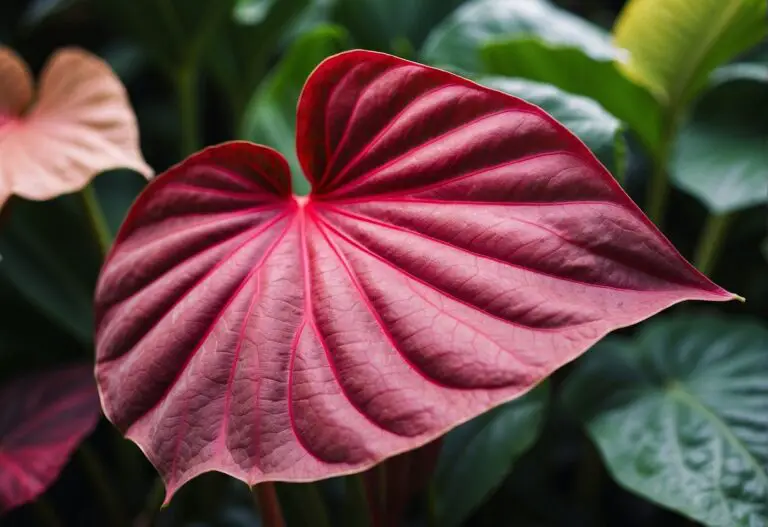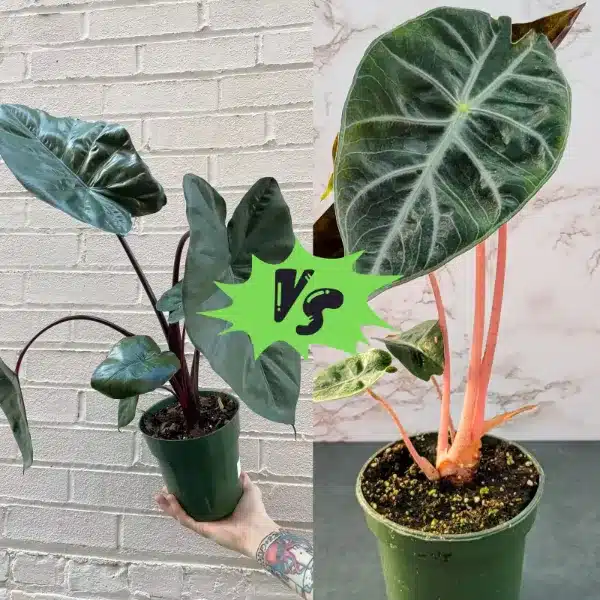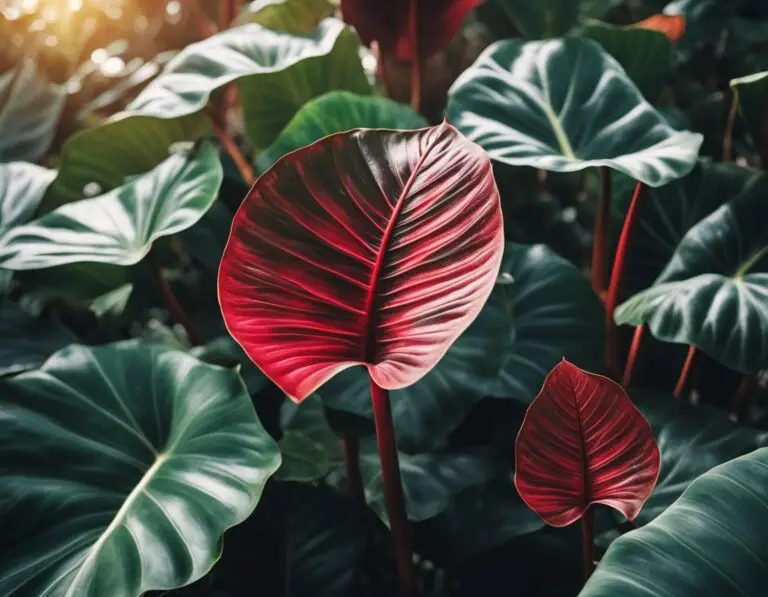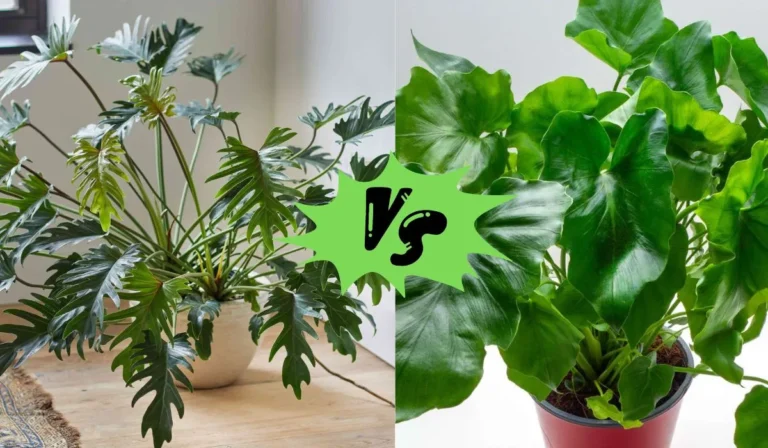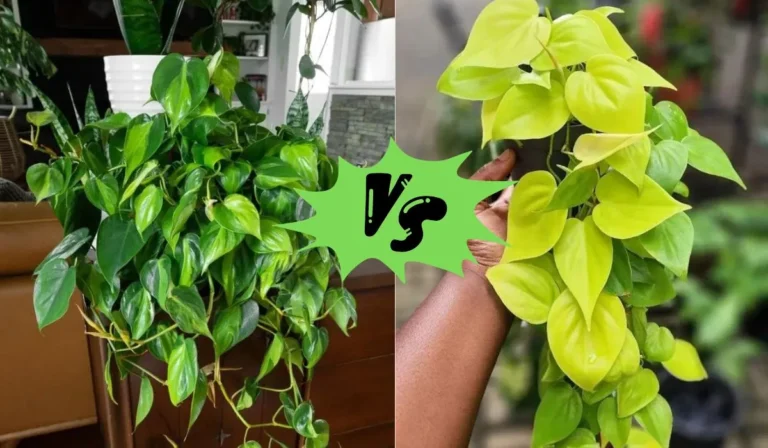Philodendron Mayoi vs Tahiti: Which One Is Right for You?
If you’re a plant enthusiast, you might have heard about Philodendron Mayoi and Tahiti. Both species belong to the Araceae family and are known for their unique foliage, making them a popular choice for indoor plants. But what are the differences between these two species, and which one is right for you?
Philodendron Mayoi and Tahiti are often confused due to their similarities in appearance. Both have deeply cut or split leaves, petioles, and veins with reddish coloration. However, upon closer inspection, you’ll notice that Philodendron Mayoi has multi-lobed leaves, while Tahiti has more elongated leaves.

In this article, we’ll explore the differences between these two species, including their soil needs, propagation methods, common pests and diseases, and more.
Key Takeaways
- Philodendron Mayoi and Tahiti may look similar, but they have distinct differences in their foliage and growth habits.
- Both species require well-draining soil, but Philodendron Mayoi prefers a slightly more acidic medium, while Tahiti can tolerate a wider range of pH levels.
- Propagating Philodendron Mayoi is best done through stem cuttings, while Tahiti can also be propagated through division.
Philodendron Mayoi vs Tahiti
If you’re looking for a new addition to your plant collection and are considering a philodendron, you might be wondering about the differences between the Philodendron Mayoi and Tahiti. Here’s what you need to know.
History of Philodendron Mayoi
Philodendron Mayoi is a rare plant that is native to South America. It is named after the collector who first discovered it in the wild, Ossamu Matsuda. It is also commonly known as Philodendron “jungle boogie” due to its unique leaf shape.
History of Philodendron Tahiti
Philodendron Tahiti is a popular houseplant that is often confused with Philodendron Mayoi. It is native to the rainforests of Central and South America. Its large, deeply cut leaves make it a striking addition to any plant collection.
Comparing Growth Patterns
Philodendron Mayoi and Tahiti have similar growth patterns and can both grow up to 3-4 feet tall. However, Philodendron Mayoi tends to grow more slowly and stays more compact than Tahiti.
Comparing Leaf Shapes
Philodendron Mayoi has multi-lobed leaves that closely resemble Tahiti. However, Philodendron Tahiti has larger and more deeply cut leaves. Both plants have green leaves with reddish petioles and veins beneath the leaves.
Comparing Care Requirements
Both Philodendron Mayoi and Tahiti prefer bright, indirect light and well-draining soil. They also require consistent moisture, but be careful not to overwater. Philodendron Mayoi is more tolerant of lower humidity levels than Tahiti, which prefers high humidity.
Here’s a quick comparison chart to summarize the differences between Philodendron Mayoi and Tahiti:
| Philodendron Mayoi | Philodendron Tahiti | |
|---|---|---|
| Leaf Shape | Multi-lobed | Deeply cut |
| Growth Rate | Slow | Fast |
| Size | Compact | Large |
| Light | Bright, indirect | Bright, indirect |
| Soil | Well-draining | Well-draining |
| Moisture | Consistent | Consistent |
| Humidity | Tolerates low | Prefers high |
Whether you choose Philodendron Mayoi or Tahiti, both plants are beautiful additions to any plant collection. Just be sure to provide them with the care they need to thrive.
What Are the Differences in Soil Needs?
When it comes to soil needs, Philodendron Mayoi and Tahiti have some differences. Here are a few things to keep in mind:
Philodendron Mayoi Soil Needs
Philodendron Mayoi prefers well-draining soil that is rich in organic matter. The soil should be moist but not waterlogged. If the soil is too dry, the plant will wilt, but if it’s too wet, the roots can rot.
To create the ideal soil for Philodendron Mayoi, mix peat moss, perlite, and vermiculite in equal parts. You can also add some orchid bark to improve drainage. Make sure the soil is slightly acidic, with a pH between 5.5 and 6.5.
Tahiti Soil Needs
Tahiti, on the other hand, prefers a soil that is more moisture-retentive. The soil should be moist but not waterlogged. If the soil is too dry, the plant will wilt, but if it’s too wet, the roots can rot.
To create the ideal soil for Tahiti, mix peat moss, perlite, and vermiculite in equal parts. You can also add some coconut coir to improve moisture retention. Make sure the soil is slightly acidic, with a pH between 5.5 and 6.5.
Key Takeaways
Here are some key takeaways to keep in mind when it comes to soil needs for Philodendron Mayoi and Tahiti:
- Philodendron Mayoi prefers well-draining soil that is rich in organic matter. The soil should be moist but not waterlogged.
- Tahiti prefers a soil that is more moisture-retentive. The soil should be moist but not waterlogged.
- To create the ideal soil for both plants, mix peat moss, perlite, and vermiculite in equal parts. You can also add some coconut coir to improve moisture retention for Tahiti or orchid bark to improve drainage for Philodendron Mayoi.
- Make sure the soil is slightly acidic, with a pH between 5.5 and 6.5, for both plants.
Remember, the right soil can make all the difference in the health and growth of your plants. By following these tips, you can ensure that your Philodendron Mayoi and Tahiti are thriving in the right conditions.
How to Propagate Each Species?
Propagating philodendron mayoi and tahiti is a great way to expand your plant collection or share with friends. Both species can be propagated through stem cuttings, but there are some differences in the process. Here’s how to propagate each species:
Philodendron Mayoi
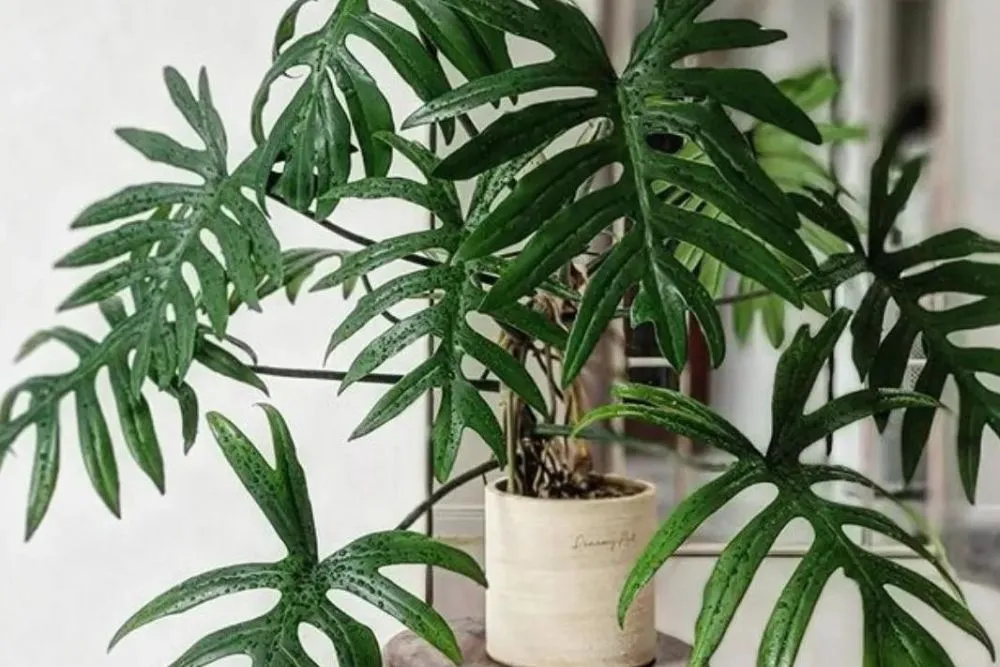
Philodendron mayoi is a relatively easy plant to propagate. Here are the steps:
- Choose a healthy stem with at least 2-3 leaves and a few nodes.
- Cut the stem just below a node with a clean, sharp pair of scissors or pruning shears.
- Remove the lower leaves on the stem, leaving only 1-2 leaves at the top.
- Dip the cut end of the stem in rooting hormone powder (optional).
- Plant the stem in a pot filled with well-draining soil.
- Water the soil thoroughly and cover the pot with a plastic bag or dome to create a humid environment.
- Place the pot in a bright, indirect light location.
- After a few weeks, check for roots by gently tugging on the stem. Once roots have formed, remove the plastic bag or dome and continue to water the plant as usual.
Philodendron Tahiti
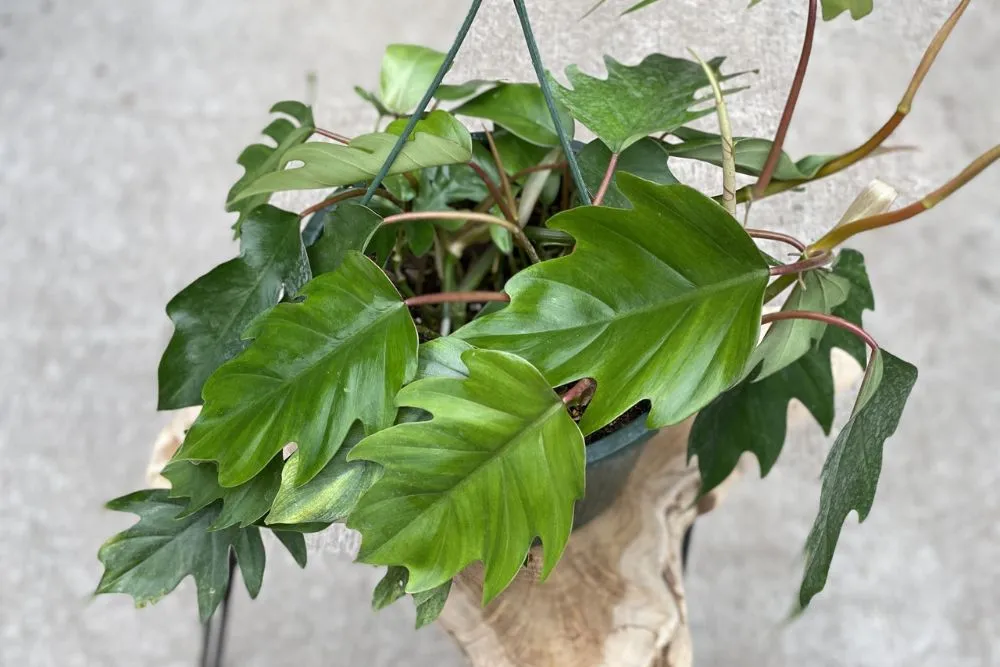
Propagating philodendron tahiti is similar to propagating philodendron mayoi. Here are the steps:
- Choose a healthy stem with at least 2-3 leaves and a few nodes.
- Cut the stem just below a node with a clean, sharp pair of scissors or pruning shears.
- Remove the lower leaves on the stem, leaving only 1-2 leaves at the top.
- Dip the cut end of the stem in rooting hormone powder (optional).
- Plant the stem in a pot filled with well-draining soil.
- Water the soil thoroughly and cover the pot with a plastic bag or dome to create a humid environment.
- Place the pot in a bright, indirect light location.
- After a few weeks, check for roots by gently tugging on the stem. Once roots have formed, remove the plastic bag or dome and continue to water the plant as usual.
Overall, propagating philodendron mayoi and tahiti is a simple process that can be done by even novice gardeners. Just be sure to provide the right growing conditions and care for your new plants, and they will reward you with beautiful foliage and a lush, tropical feel to your home.
What Are the Common Pests and Diseases?
When it comes to philodendrons, pests and diseases are a common problem. But don’t worry, with proper care and attention, you can keep your philodendron Mayoi or Tahiti healthy and happy. Here are some of the most common pests and diseases that you should watch out for:
Pests
- Aphids: These tiny insects are a common pest that can attack philodendrons. They feed on the sap of the plant and can cause stunted growth, yellowing leaves, and distorted foliage. To get rid of aphids, you can use insecticidal soap or neem oil.
- Spider Mites: These pests are very small and can be difficult to spot. They feed on the underside of leaves and can cause yellowing, wilting, and webbing. To control spider mites, you can use insecticidal soap or neem oil.
- Mealybugs: These pests are white, fluffy insects that can be found on the leaves, stems, and roots of philodendrons. They feed on the sap of the plant and can cause yellowing, wilting, and distorted growth. To control mealybugs, you can use insecticidal soap or neem oil.
- Scale Insects: These pests are small, oval-shaped insects that can be found on the leaves and stems of philodendrons. They feed on the sap of the plant and can cause yellowing, wilting, and distorted growth. To control scale insects, you can use insecticidal soap or neem oil.
Diseases
- Leaf Spot: This disease is caused by a fungus and can cause brown or black spots on the leaves of philodendrons. It can be caused by overwatering, poor air circulation, or high humidity. To control leaf spot, you can remove infected leaves and improve the growing conditions.
- Blight: This disease is caused by a fungus and can cause the leaves of philodendrons to turn brown or black and wilt. It can be caused by overwatering, poor air circulation, or high humidity. To control blight, you can remove infected leaves and improve the growing conditions.
- Xanthomonas Leaf Spot and Tip Burn: This disease is caused by bacteria and can cause yellowing of leaf tips that progress towards the margins. It can be caused by overwatering, poor air circulation, or high humidity. To control Xanthomonas leaf spot and tip burn, you can remove infected leaves and improve the growing conditions.
Frequently Asked Questions (FAQs)
What are the distinguishing features of Philodendron Mayoi and Tahiti?
Philodendron Mayoi and Tahiti are both beautiful plants that have distinguishing features. Philodendron Mayoi has fronds that resemble those of a palm tree, while Philodendron Tahiti has large, glossy leaves with a distinct pattern. Philodendron Mayoi has a more compact growth habit, while Philodendron Tahiti can grow quite large.
What is the market price for Philodendron Mayoi?
The market price for Philodendron Mayoi can vary depending on the size and condition of the plant. On average, a small to medium-sized plant can cost between $50 to $100, while larger plants can cost up to $300.
What are the care requirements for Philodendron Tahiti?
Philodendron Tahiti requires bright, indirect light and well-draining soil. It also needs to be watered regularly, but not overwatered, as this can lead to root rot. Fertilizing once a month during the growing season can also help promote healthy growth.
Is Philodendron Mayoi a rare plant?
Yes, Philodendron Mayoi is a rare plant that is highly sought after by collectors. It is not commonly found in nurseries, and when it is, it can be quite expensive.
What are the differences between Philodendron Mayoi and Pedatum?
Philodendron Mayoi and Pedatum are two different species of philodendron. Philodendron Mayoi has fronds that resemble those of a palm tree, while Philodendron Pedatum has more delicate, fern-like fronds. Additionally, Philodendron Mayoi has a more compact growth habit, while Philodendron Pedatum can grow quite large.
What are the unique characteristics of Philodendron Bipennifolium?
Philodendron Bipennifolium is a beautiful plant with unique characteristics. It has large, heart-shaped leaves that are deeply lobed and can grow up to two feet long. The plant also has aerial roots that can be used to climb up supports, such as a moss pole. Additionally, Philodendron Bipennifolium is known for its ability to purify indoor air.
Conclusion
In conclusion, both Philodendron Mayoi and Philodendron Tahiti are beautiful houseplants that can add a tropical vibe to your home. However, there are some differences between the two that you should consider before making your choice.
Philodendron Mayoi is a rare species that has a growing demand among plant enthusiasts. It has unique architectural split-leaves that can add a touch of elegance to any room. It prefers bright natural light and needs to be kept humid to thrive. On the other hand, Philodendron Tahiti is a hybrid plant that is easier to find and care for. It has large, heart-shaped leaves that can grow up to 12 inches long. It can tolerate lower light conditions and does not require high humidity levels.
If you are looking for a low-maintenance plant that can tolerate low light conditions, Philodendron Tahiti is an excellent choice. It is also more affordable and easier to find than Philodendron Mayoi. However, if you are a plant enthusiast who is looking for a rare and unique plant, Philodendron Mayoi is the way to go. It requires a bit more attention and care, but it is worth it for its stunning appearance.
In terms of propagation, both plants can be propagated through stem cuttings. Philodendron Mayoi can also be propagated through division. When it comes to pests and diseases, both plants are susceptible to mealybugs, spider mites, and root rot. Therefore, it is essential to keep an eye on your plants and take action immediately if you notice any signs of infestation or disease.
Overall, both Philodendron Mayoi and Philodendron Tahiti are great houseplants that can bring a touch of the tropics to your home. Consider your preferences and needs before making your choice, and enjoy the beauty and benefits of having a Philodendron plant in your home.

